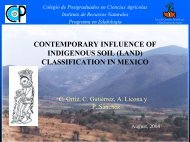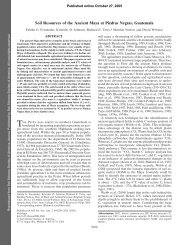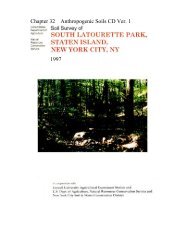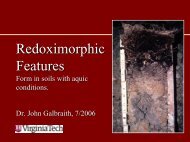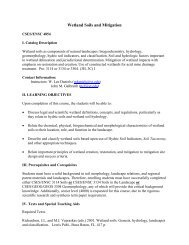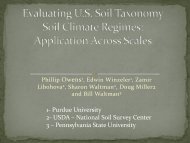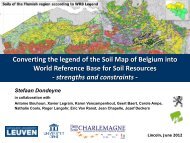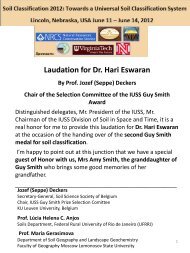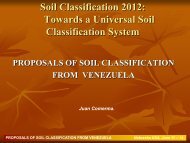Nebraska Soils Field Trip - Virginia Tech
Nebraska Soils Field Trip - Virginia Tech
Nebraska Soils Field Trip - Virginia Tech
Create successful ePaper yourself
Turn your PDF publications into a flip-book with our unique Google optimized e-Paper software.
4th IUSS Soil Classification Conference <strong>Field</strong> Tour Guidebook<br />
Location of MLRA 106 in Land Resource Region M<br />
Physiography<br />
This area is almost entirely in the<br />
Dissected Till Plains Section of the<br />
Central Lowland Province of the<br />
Interior Plains. The southern tip is in<br />
the Osage Plains Section of the same<br />
province and division. Interstate 70 is<br />
close to the boundary between these<br />
two sections in this MLRA. This area<br />
is a dissected glacial drift plain.<br />
Ridgetops are broad and smooth, and<br />
slopes are nearly level to strongly<br />
sloping. Stream valleys are bordered<br />
by relatively narrow bands of hilly and<br />
steep slopes. Valley floors are<br />
typically narrow, except along the<br />
larger rivers and their primary<br />
tributaries. Elevation ranges from 980<br />
to 1,650 feet (300 to 505 meters),<br />
increasing from east to west. Local<br />
relief is mainly 10 to 20 feet (3 to 6<br />
meters), but some of the larger valley<br />
floors are 80 to 160 feet (25 to 50<br />
meters) or more below the level of the<br />
adjacent uplands.<br />
The extent of the major Hydrologic Unit Areas (identified by four-digit numbers) that make up this MLRA is<br />
as follows: Kansas (1027), 51 percent; Missouri-Nishnabotna (1024), 32 percent; and Platte (1020), 17<br />
percent. The Little Nemaha River and the North Fork of the Big Nemaha River flow into the Missouri<br />
River, which is just east of the part of this area in <strong>Nebraska</strong>. The Big Blue River flows through Beatrice,<br />
<strong>Nebraska</strong>, and on into the part of this area in Kansas. Salt- Wahoo Creeks flow through Lincoln and<br />
Wahoo and on into the Platte River in the northern part of the area. The Big Blue joins the Black<br />
Vermillion River at Tuttle Creek Lake in the southern end of the MLRA, in Kansas. The Soldier and<br />
Delaware Rivers also are in the part of the MLRA in Kansas.<br />
Geology<br />
Loess covers the surface of almost all of the uplands in this MLRA. Glacial drift underlies the loess.<br />
Alluvial clay, silt, sand, and gravel are deposited in all of the stream and river valleys. The alluvial<br />
deposits can be extensive in the major river valleys. Paleozoic sandstone, shale, and limestone units are<br />
exposed in a few road cuts and in the walls of valleys along the major streams on the east side of the<br />
area, near the bluffs along the Missouri River. Limestone and shale (clay) quarries are in this MLRA.<br />
Climate<br />
The average annual precipitation in most of this area is 28 to 40 inches (710 to 1,015 millimeters),<br />
increasing from northwest to southeast. About three-fourths of the precipitation falls as high-intensity,<br />
convective thunderstorms from late in spring through early in autumn. The scant precipitation in winter<br />
occurs mainly as snow. The average annual temperature is 50 to 55 degrees F (10 to 13 degrees C). The<br />
freeze-free period averages about 195 days and ranges from 175 to 215 days.<br />
21





